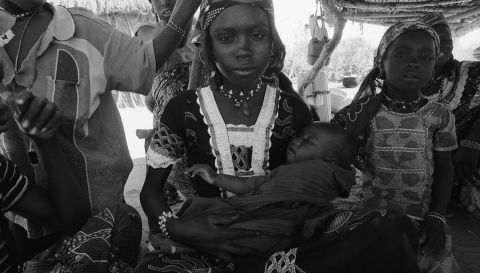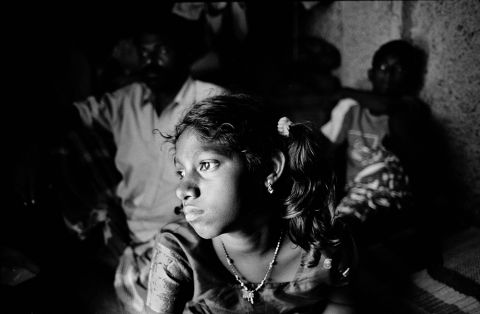The Revisited stories
In 2005, award-winning photographer Nick Danziger partnered with World Vision to document the lives of women and children in eight countries. The images and stories sought to amplify the voices of people in vulnerable communities and highlight the ambitions of the Millennium Development Goals. Nick returned five years later, and again in 2015, to assemble an extraordinary, stark portrait of life on the edge over the course of a decade.
The images and personal accounts now on display in the Revisited photo exhibition illustrate that despite the remarkable successes of the Millennium Development Goals, such as halving the number of people living in extreme poverty, over a billion people on the extreme margins of society were unreached by the goals, unable to benefit from the tide that lifted their neighbours.
World Vision believes new Sustainable Development Goals must endeavour to reach the most vulnerable children first.
Below you can read about some of the children featured in the Revisited exhibition.
Aissha, Niger

Aissha is one of many millions of children born into extreme poverty and conflict around the turn of the new Millennium. Her semi-nomadic pastoralist family lived in a thatched hut among the dust of the Saharan Niger.
Aissha’s family once owned cattle, goats and camels, but in 2005 the camels were stolen by men brandishing assault rifles. The remaining livestock starved to death during a severe drought. Her parents were driven to scratch dry riverbeds in search of roots.
An emergency feeding centre was eventually established, but Aissha’s friends continued to die of preventable diseases like malaria – which kills over half a million people each year.
Now a 12-year-old shepherdess, Aissha will be married next year. Her family couldn’t afford another mouth to feed so her father sold her to an older man for the equivalent of $35. It is also likely her family believed that she would be safer if she were married. In Niger, 76 per cent of girls are married before they reach 18 years of age.
While the Millennium Development Goals have led to impressive progress for many, they largely failed the 1.5 billion people living in conflict ravaged countries. People like Aissha. Conflict remains the biggest threat to development and children remain most vulnerable. Nearly two-thirds of conflict affected countries will fall short of the Millennium Development Goals aim to halve poverty by 2015. Just one-fifth will halve infant mortality.
Goal 16 of the new Sustainable Development Goals is focused on promoting peaceful and inclusive societies. Governments, businesses, civil society organisations and the public acting in collaborative partnership to accomplish this goal will be critical to the success of all the goals.
World Vision's peace building work assists communities to protect and empower children affected by violence. This includes strategies to enable communities to resolve their own conflicts, heal broken relationships, and nourish more equitable judicial structures.
Goal 5 of the goals is focussed on gender equality and Goal 4 on quality education. World Vision has found that girls who have access to quality primary and secondary education are less likely to accept early marriage.
In one community in Niger where World Vision works, people acknowledged the positive impacts of girls’ education in their village, noting mothers who had received an education tended to have healthier children. “We try to send girls to school as well as boys because we have seen there is a difference in girls who are educated. Even their homes are cleaner,” said one father in Niger.
Franklin, Honduras
Franklin was born into extreme poverty as the world ushered in the new Millennium, 15 years ago. His family lived in a makeshift shack clinging to a hillside in the Honduran capital, Tegucigalpa.
Undeterred by the lack of running water or reliable electricity in his home, Franklin read his school books, studied hard, and by age 10 he was top of his class in primary school. With a near perfect mark in mathematics, he dreamed of becoming a banker.
It was not to be. Even though secondary school is free in Honduras, neither his grandmother nor his mother could afford the daily bus fare to get there, still less the $25 needed for his uniform. Now aged 15 and with little prospect of a job, Franklin was recruited into a neighbourhood gang, dealing in drugs and has becoming addicted himself.
One night Franklin watched as two of his friends were shot to death. He tried to leave the gang but they wouldn’t let him go. When he refused to deal again, they threatened his life. He now sleeps with a knife under his bed. Dreams of a better future have long faded away.
When the Millennium Development Goals were launched in the year of his birth, they were meant to help Franklin and millions like him. Overall, the goals can point to impressive achievements worldwide, roughly halving the number of people living in extreme poverty. But those on the extreme margins of society have remained largely untouched by the anti-poverty initiatives these goals spurred into existence.
What difference will the successor to the Millennium Development Goals make in the lives of children like Franklin? The protection of children from all forms of violence is closely linked to the development and success of their societies. And for the first time, the new universal Sustainable Development Goals include a target on ending violence against children.
World Vision’s programmes strive to ensure physical, emotional, psychological, and spiritual needs of the most vulnerable children are met within caring and protective families and communities – focusing on activities that prevent them from falling into harmful situations; protect those who are in immediate danger through more responsive care; and restore child survivors of abuse, exploitation, or violence through appropriate community-based counselling and care.
Kousalya and Ajid, India

Kousalya was just five-years-old when she tried to flag down a rickshaw to take her dying mother to hospital. The drivers all refused. She didn’t have enough to pay the small fare.
Kousalya and her brother Ajid were born onto the streets of Chennai around the turn of the Millennium. The children rarely attended school. Instead, they helped their mother hawk flowers to passing motorists. They were excited when they learned their mother was pregnant again – they thought a baby brother would bring excitement to their tedious daily routine. But four months after his birth the infant died due to malnutrition.
The children were always hungry. Kousalya’s mother had to give up work after contracting AIDS from her husband. Soon, she became too frail to even leave her makeshift bed.
After their mothers death the children’s father agreed to take care of them. The HIV medication he was on needed to be taken with food, so every day he made a difficult choice whether to feed himself or his children.
Today, Ajid still lives with his father, new wife and three relatives in a small home constructed of discarded cardboard and tarpaulin. Kousalya has since moved to Pondicherry, where she works as a nanny. She says she doesn’t want to return to Chennai. “When I go home I’m always hungry.”
The Millennium Development Goals were meant to help Kousalya, Ajid and millions like them. Overall, the goals can point to impressive results, including almost halving the proportion of undernourished people in the developing world. But those on the extreme margins of society have remained largely untouched by these anti-poverty initiatives.
Today over 160 million children under age five are stunted, and undernutrition remains the biggest underlying cause of preventable child deaths. Those who survive face a lifetime of poor educational attainment and physical weakness for which there is little treatment.
Eliminating hunger and malnutrition will have a profound impact on children’ ability to survive, grow and learn. It can also shape the long-term stability and prosperity of families, communities and countries. Children who are properly nourished are better able to contribute to society throughout their lives.
Goal 2 of the new Sustainable Development Goals is focused on ending hunger and improving nutrition for everyone – with a focus on reaching those furthest behind first. World Vision is working to address hunger and boost nutrition through a range of evidence-based programmes aimed at pregnant women, new mothers and children under two. This includes promoting immediate and exclusive breastfeeding and ensuring access to an appropriate, vitamin-rich diet.